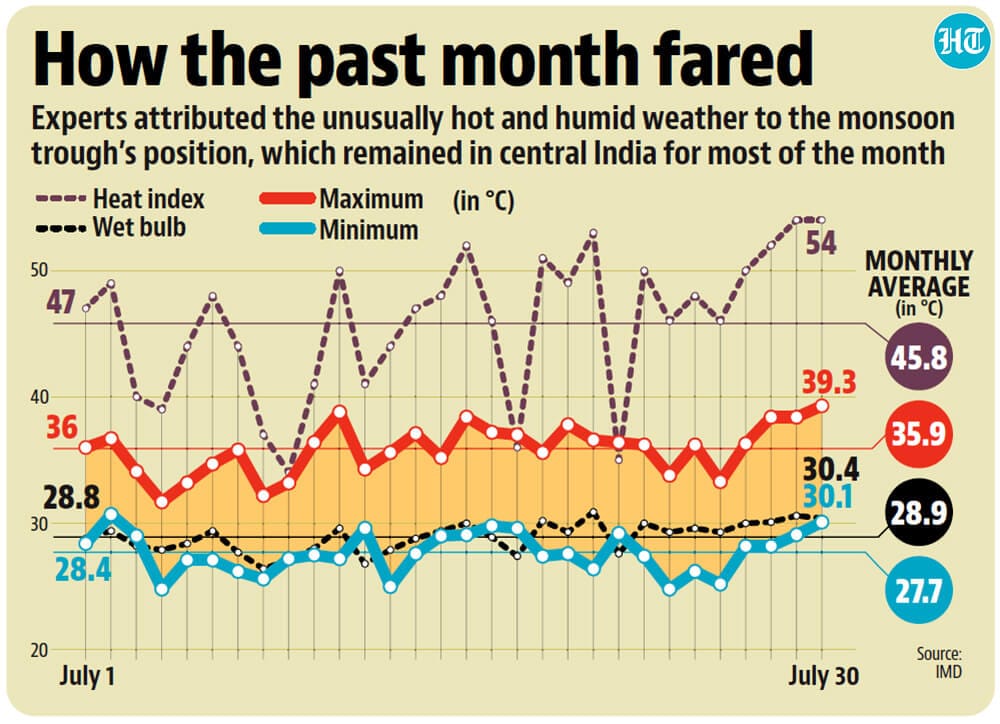Despite recording over 200mm of rainfall in July, Delhi recorded hot and humid weather, characterised by low wind speeds, high moisture, and the absence of active weather systems. The monsoon trough largely remained south of Delhi-NCR, closer to Central India, resulting in only patchy light to moderate rains, experts said.
Visitors at Kartavya Path, New Delhi face light rain on Tuesday as high humidity makes Delhi swelter. (Sanjeev Verma/HT Photo)
According to the India Meteorological Department (IMD), Delhi’s average maximum temperature in July was 35.8°C, slightly above the long-period average (LPA). However, high humidity levels – over 50% on most days in July – led to a Heat Index (HI) or ‘real feel’ of 45.8°C, making it feel significantly warmer than the recorded maximum temperature.
The thermal discomfort was further highlighted by a high average wet-bulb temperature of 28.9°C, with several days exceeding 30°C. A wet-bulb temperature above 28°C makes physical labour difficult, and over 32°C is dangerous for even healthy individuals. At 35°C, the maximum threshold, humans can no longer regulate body temperatures, leading to heatstrokes and potential collapse.
Experts attributed the unusual weather to the monsoon trough’s position. Mahesh Palawat, vice president at Skymet, explained that the trough was near Central India for 80% of July, which resulted in some cloudiness and moisture but insufficient rainfall. Slymet also had no weather systems prevailing over the region, which could have again led to rain and high wind speeds, he said.
Palawat further explained areas north of the monsoon trough see easterly moisture-laden winds, which maintain high humidity throughout the day. “Delhi-NCR, Haryana, UP and Punjab have all recorded similar weather, owing to this situation,” he said, adding the only active western disturbance Delhi saw this month was between July 22 and 25.
Safdarjung, representing Delhi’s weather, received 203.7mm of rainfall this month till 5.30pm, close to the normal long-period average (LPA) of 209.7mm. Rain was recorded on 17 days out of 30, but no heavy rainfall spells were observed at the base observatory. In June, Delhi recorded 243.3mm of rainfall, mainly due to a single-day spell of 228.1mm on June 28. Separately, in July 2023, Delhi recorded 384.6mm of rainfall.
The IMD classifies rainfall as ‘very light’ when it is below 2.4mm in 24 hours; as light when it is between 2.5 and 15.5mm; as ‘moderate’ when it is between 15.6mm and 64.4mm; as ‘heavy’ when it is between 64.5mm and 115.5mm and over 115.6mm is ‘very heavy’ rainfall.

Three moderate spells of rain were recorded at Safdarjung, with the highest 24-hour spell being 39.4mm, on July 25. Across the city, a handful of stations have recorded heavy rainfall. On July 24, 80mm of rainfall was recorded at Pusa, followed by 73mm at Pitampura. On July 26, 99mm was recorded at the Ridge in north Delhi, followed by 93.5mm at Delhi University. An almost heavy rainfall spell of 58mm was recorded in a six-hour period at Pusa on Saturday evening, which led to waterlogging and flooding of the basement in Rajendra Nagar, killing three.
“Normally, we see one to two spells of heavy rainfall in July as the trough is closer to Delhi and northern India. We expect it to return closer to the capital from Wednesday and remain in this area till Friday,” Palawat added.
IMD data showed the average monthly maximum temperature of 35.8°C was the highest for July since 2021 (36.5°C). Nights were even warmer, with the average monthly minimum temperature recorded at 27.6°C, the highest since 2014 (27.8°C). The average minimum temperature based on the long-period average is 27.5°C.
HT calculated the HI and wet bulb for July at 2.30pm daily, using a globally recognised formula developed by the National Oceanic and Atmospheric Administration. This factors in air temperature and relative humidity to indicate the feel of temperature on the human skin. No historical data was available as the IMD does not calculate these two parameters.
On Tuesday, Delhi’s maximum temperature was 39.3°C, which was five degrees above normal. Meanwhile, a relative humidity of 54% made the HI 54°C on Tuesday. The wet bulb was 30.4°C at the same time. Meanwhile, the minimum was 30.1°C, three notches above normal.Delhi’s relative humidity oscillated between 53% and 85% throughout the day.
An IMD official said with limited activity seen from weather systems around Delhi NCR, wind speeds have also been low this month.
“When moisture is high and wind speed low, the impact of high humidity is worsened. This is what is making it uncomfortable to be outdoors at present. At the same time, we are seeing spells of sunshine, which only adds to our discomfort,” the official explained, adding that even if May had dry heat, with the body able to sweat easily, humid heat is arguably worse, as it makes sweating difficult.
Forecasts predict marginal relief starting Wednesday, with lower maximum temperatures and increased wind speeds. The IMD issued an orange alert for Wednesday, forecasting light to moderate showers and isolated heavy rainfall. A yellow alert for Thursday and Friday predicts light to moderate rains.
“Till Friday, we can expect decent rain as the monsoon trough will come close to Delhi-NCR. This should provide marginal relief as the temperature will dip and winds will also increase,” Palawat said.
Images are for reference only.Images and contents gathered automatic from google or 3rd party sources.All rights on the images and contents are with their original owners.



Comments are closed.